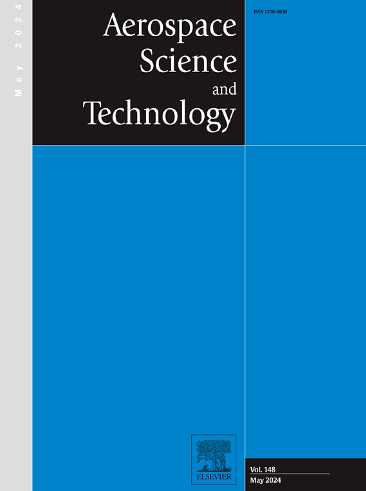Fuel stratification effects on thermoacoustic instability for swirl spray flame in an aero-engine centrally-staged combustor
IF 5
1区 工程技术
Q1 ENGINEERING, AEROSPACE
引用次数: 0
Abstract
The centrally-staged combustor features a flexible radial fuel stratification to achieve well-organized energy utilization but still faces serious thermoacoustic instability. In this study, we conducted experiments with four stratification ratios (SRs) under the realistic stratified swirl spray flame configuration. The stratification effect on thermoacoustic instability is investigated using the 20 kHz simultaneous PIV and CH2O-PLIF optical diagnostic. The combustor is prone to severe thermoacoustic oscillation at lower SR, in which the pressure fluctuation substantially follows the heat release dynamic with a short time delay. At higher SR, the relative phase between them becomes irregular accompanied by intermittent oscillations. Two types of flame dynamics are found. The heat release region features an axial mode for lower SR, while it presents the transverse oscillation which destroys the thermoacoustic coupling for higher SR. Further, a coupling metric quantifying the similarity between the vortex probability distribution and flame surface density is proposed to measure the vortex-flame coupling. The highest value for the lowest SR is attributed to the strong flame-flow interaction downstream of the primary recirculation zone, which contributes to the unsteady heat release. Finally, it is found that the local flame stabilization is similar to the counterflow flame.
燃油分层对航空发动机中央分级燃烧室涡流喷射火焰热声不稳定性的影响
中央分级燃烧室的特点是灵活的径向燃料分层,以实现良好的组织能源利用,但仍然面临严重的热声不稳定性。在本研究中,我们在真实的分层漩涡喷射火焰配置下进行了四种分层比(SRs)的实验。利用20 kHz同步PIV和cho2 - plif光学诊断,研究了分层效应对热声不稳定性的影响。在较低SR下,燃烧室容易发生严重的热声振荡,压力波动基本上跟随热释放动态变化,且具有较短的时滞。在较高的SR下,它们之间的相对相位变得不规则,并伴有间歇性振荡。发现了两种类型的火焰动力学。在较低SR时,热释放区表现为轴向模式,而在较高SR时,热释放区表现为破坏热声耦合的横向振荡。在此基础上,提出了一种量化涡概率分布与火焰表面密度相似度的耦合度量来测量涡-火焰耦合。最低SR的最大值归因于一次再循环区下游强烈的火焰-流相互作用,这导致了不稳定的放热。最后,发现局部火焰稳定与逆流火焰相似。
本文章由计算机程序翻译,如有差异,请以英文原文为准。
求助全文
约1分钟内获得全文
求助全文
来源期刊

Aerospace Science and Technology
工程技术-工程:宇航
CiteScore
10.30
自引率
28.60%
发文量
654
审稿时长
54 days
期刊介绍:
Aerospace Science and Technology publishes articles of outstanding scientific quality. Each article is reviewed by two referees. The journal welcomes papers from a wide range of countries. This journal publishes original papers, review articles and short communications related to all fields of aerospace research, fundamental and applied, potential applications of which are clearly related to:
• The design and the manufacture of aircraft, helicopters, missiles, launchers and satellites
• The control of their environment
• The study of various systems they are involved in, as supports or as targets.
Authors are invited to submit papers on new advances in the following topics to aerospace applications:
• Fluid dynamics
• Energetics and propulsion
• Materials and structures
• Flight mechanics
• Navigation, guidance and control
• Acoustics
• Optics
• Electromagnetism and radar
• Signal and image processing
• Information processing
• Data fusion
• Decision aid
• Human behaviour
• Robotics and intelligent systems
• Complex system engineering.
Etc.
 求助内容:
求助内容: 应助结果提醒方式:
应助结果提醒方式:


